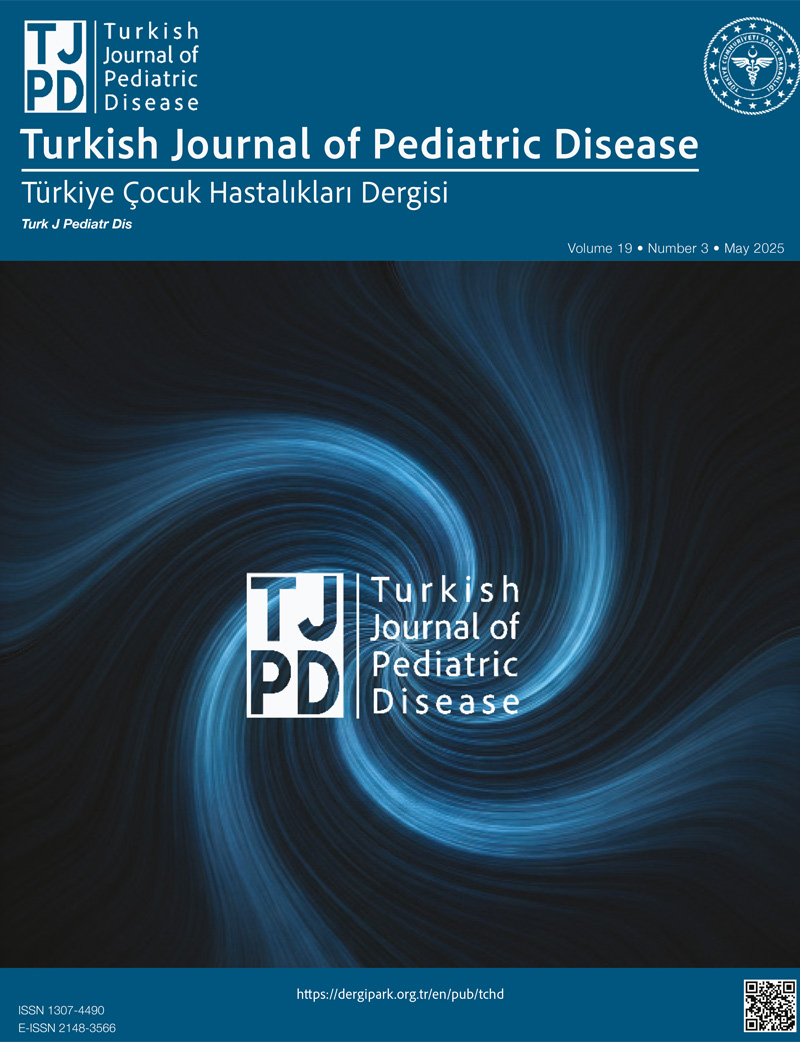Abstract
Objective: Chronic urticaria (CU) is defined as the recurring presence of urticaria, angioedema, or both, for a duration of six weeks or more. In most patients, it is a self-limiting disease. The study aimed to investigate the clinical findings, comorbidities, laboratory results, response to treatment and prognosis in children with CU.
Material and Methods: Patients aged 0-18 years with CU followed up at the Pediatric Allergy and Immunology Outpatient Clinic of Selcuk University Faculty of Medicine Hospital between January 2022 and March 2024 were included, and their medical records were retrospectively analyzed.
Results: The study sample included 74 patients with CU. About 55.4% of the patients were girls. The mean age of the patients was 11 year (2.3-17.9). The mean follow-up period was 475 days (129-925). Sixteen patients (21.6%) had angioedema, while 15 patients (20.2%) reported presence of a trigger. Eleven patients (14.8%) had dermographism. Four patients (5.4%) were anti-thyroid peroxidase positive and seven patients (9.4%) were antinuclear antibody positive. Eosinopenia was present in 10 patients (13.5%), whereas basopenia was present in only two (2.7%) patients. Skin prick test detected positivity in 24 patients (32.4%). Sixty-eight patients (91.9%) responded to antihistamine and/or montelukast treatment, and omalizumab was prescribed to six patients (8.1%) showing no response to the conventional treatment.
Conclusion: In pediatric CU patients, the disease is often self-limiting without the need for treatment with omalizumab. Drug compliance should be evaluated in patients with poor disease control.
Keywords: Antihistamine, Chronic urticaria, Eosinopenia, Prognosis
References
- Arga M, Asılsoy S, Cetinkaya F, Oner Erkekol F, Gelıncık A, Gul U, et al. Turkish National Society of Allergy and Clinical Immunology Position Paper: Diagnosis and Management of Urticaria. Asthma Allergy Immunol 2018; 16:97-122.
- Bernstein JA, Lang DM, Khan DA, Craig T, Dreyfus D, Hsieh F, et al. The diagnosis and management of acute and chronic urticaria: 2014 update. J Allergy Clin Immunol 2014;133:1270-7.
- Powell RJ, Leech SC, Till S, Huber PA, Nasser SM, Clark AT. British Society for Allergy and Clinical Immunology. BSACI guideline for the management of chronic urticaria and angioedema. Clin Exp Allergy 2015;45:547-65.
- Caffarelli C, Paravati, F, El Hachem M, Duse M, Bergamini M, Simeone G, et al. Management of chronic urticaria in children: A clinical guideline. Ital. J. Pediatr 2019; 45:101.
- Zuberbier T, Abdul Latiff AH, Abuzakouk M, Aquilina S, Asero R, Baker D, et al. The international EAACI/GA2LEN/EuroGuiDerm/APAAACI guideline for the definition, classification, diagnosis, and management of urticaria. Allergy 2022;77:734–66.
- Greiner B, Nicks S, Adame M, McCracken J. Pathophysiology, Diagnosis, and Management of Chronic Spontaneous Urticaria: A Literature Review. Clin Rev Allergy Immunol 2022 ;63:381-9.
- Saini SS, Kaplan AP. Chronic Spontaneous Urticaria: The Devil’s itch. J Allergy Clin Immunol Pract 2018;6:1097-106.
- Chin ML. It Comes and Goes. Pediatric Chronic Spontaneous Urticaria. Cureus 2023;15: e 40006.
- Zhao ZT, Ji CM, Yu WJ, Meng L, Hawro T, Wei JF, et al. Omalizumab for the treatment of chronic spontaneous urticaria: a meta-analysis of randomized clinical trials. J Allergy Clin Immunol 2016;137:1742-50.
- Shah AD, Denaxas S, Nicholas O, Hingorani AD, Hemingway H. Low eosin- ophil and low lymphocyte counts and the incidence of 12 cardiovascular dis- eases: a CALIBER cohort study. Open Heart 2016;3:e000477.
- Kolkhir P, Church MK, Altrichter S, Skov PS, Hawro T, Frischbutter S, et al. Eosinopenia, in Chronic Spontaneous Urticaria, Is Associated with High Disease Activity, Autoimmunity, and Poor Response to Treatment. J Allergy Clin Immunol Pract 2020; 8:318–325.e15.
- Altrichter S, Fok JS, Jiao Q, Kolkhir P, Pyatilova P, Romero SM, et al. Total IgE as a marker for c hronic spontaneous urticaria. Allergy Asthma Immunol Res 2021;13:206-18.
- Ansotegui IJ, Melioli G, Canonica GW, Caraballo L, Villa E, Ebisawa M, et al. IgE allergy diagnostics and other relevant tests in allergy, a World Allergy Organization position paper. World Allergy Organ J 2020;25;13:100080.
- Chansakulporn S, Pongpreuksa S, Sangacharoenkit P, Pacharn P, Visitsunthorn N, Vichyanond P, et al. The natural history of chronic urticaria in childhood: a prospective study. J Am Acad Dermatol 2014;71:663-8.
- Lachover-Roth I, Rabie A, Cohen-Engler A, Rosman Y, Meir-Shafrir K, Confino-Cohen R. Chronic urticaria in children – new insights from a large cohort. Pediatr Allergy Immunol 2021;32:999-1005.
- Park YM, Oh MS, Kwon JW. Predicting inadequate treatment response in children with chronic spontaneous urticaria. Pediatr. Allergy Immunol 2020;31:946-53.
- Sahiner UM, Civelek E, Tuncer A, Yavuz ST, Karabulut E, Sackesen C, et al. Chronic urticaria: Etiology and natural course in children. Int Arch Allergy Immunol 2011;156, 224-30.
- Sánchez-Borges M, Asero R, Ansotegui IJ, Baiardini I, Bernstein JA, Canonica GW, et al; WAO Scientific and Clinical Issues Council. Diagnosis and treatment of urticaria and angioedema: a worldwide perspective. World Allergy Organ J 2012;5:125-47.
- Özçeker D, Can PK, Terzi Ö, Ornek SA, Degirmentepe EN, Kızıltac K, et al. Differences between adult and pediatric chronic spontaneous urticaria from a cohort of 751 patients: Clinical features, associated conditions and indicators of treatment response. Pediatric Allergy and Immunology 2023;34:e13925.
- Özhan AK, Arıkoğlu T. Evaluation of Pediatric Chronic Urticaria with Emphasis on Clinical and Laboratory Characteristics and Treatment Response to Omalizumab: A Real-Life Experience from a Tertiary Allergy Center. Children (Basel) 2024;11:86.
- Sarbjit S Saini, Allen P Kaplan. Chronic Spontaneous Urticaria: The Devil’s Itch. Clin Immunol Pract 2018;6:1097-106.
- Kolkhir P, Altrichter S, Hawro T, Maurer M. C-reactive protein is linked to disease activity, impact, and response to treatment in patients with chronic spontaneous urticaria. Allergy 2018;73:940-8.
Copyright and license
Copyright © 2025 The Author(s). This is an open access article distributed under the Creative Commons Attribution License (CC BY), which permits unrestricted use, distribution, and reproduction in any medium or format, provided the original work is properly cited.






